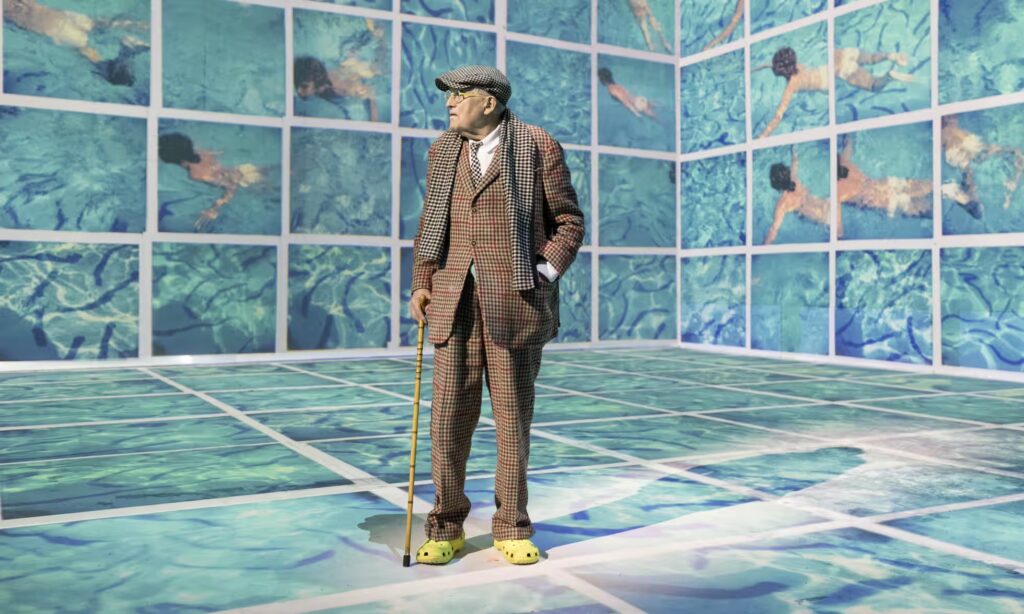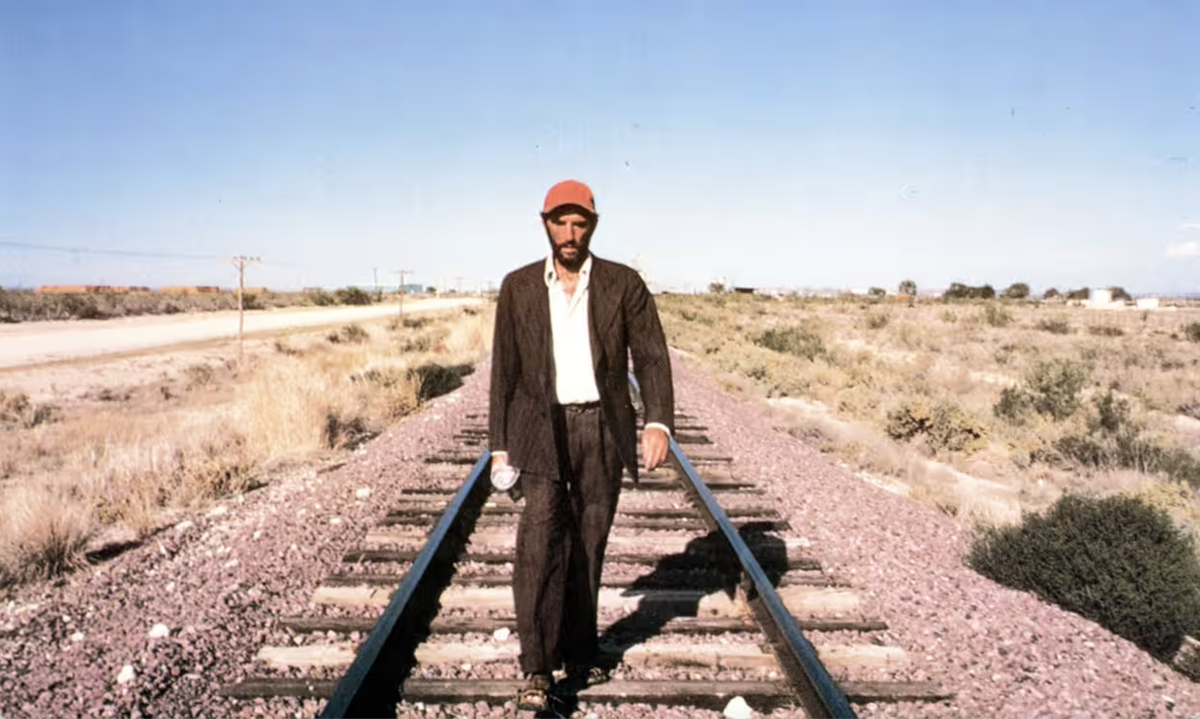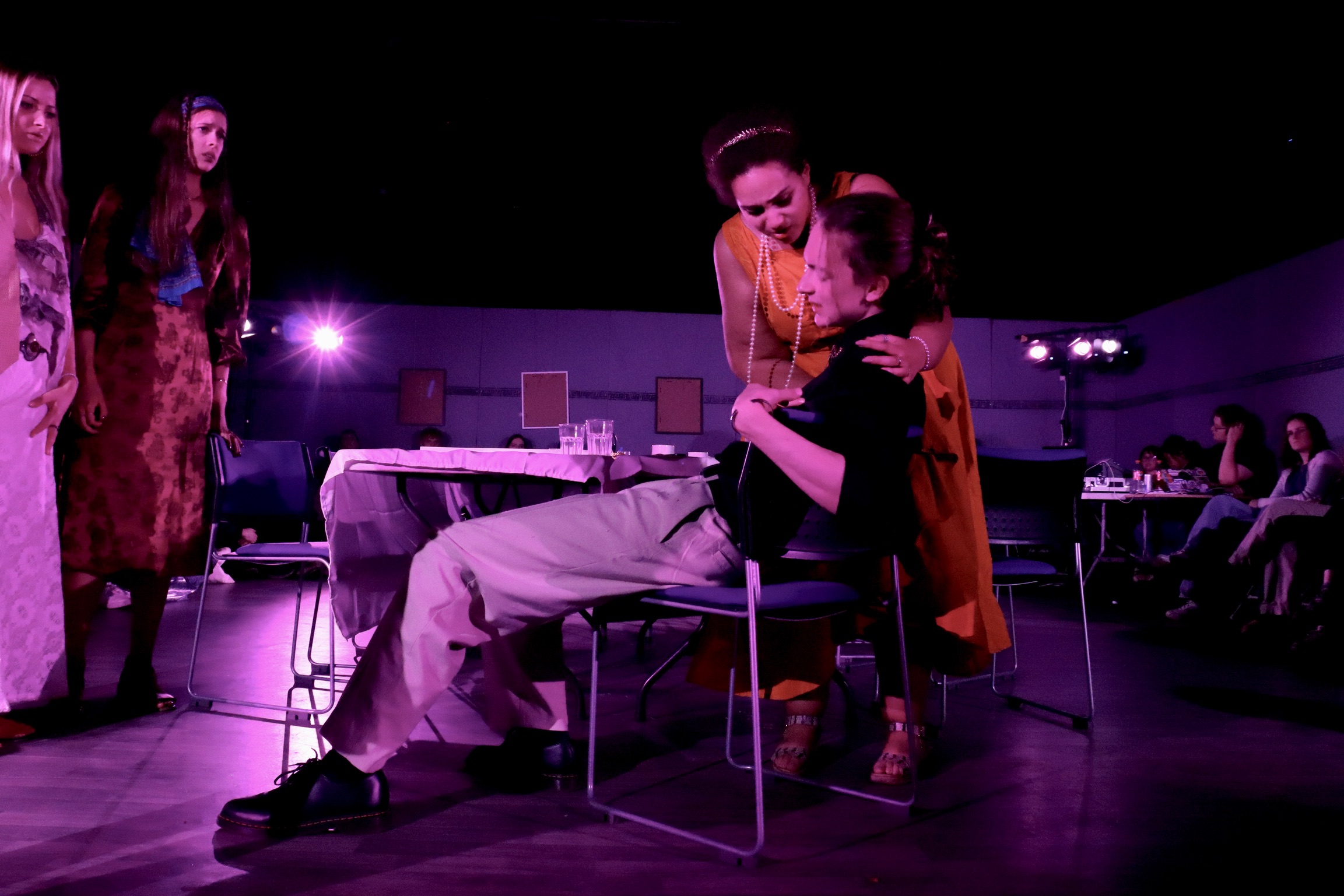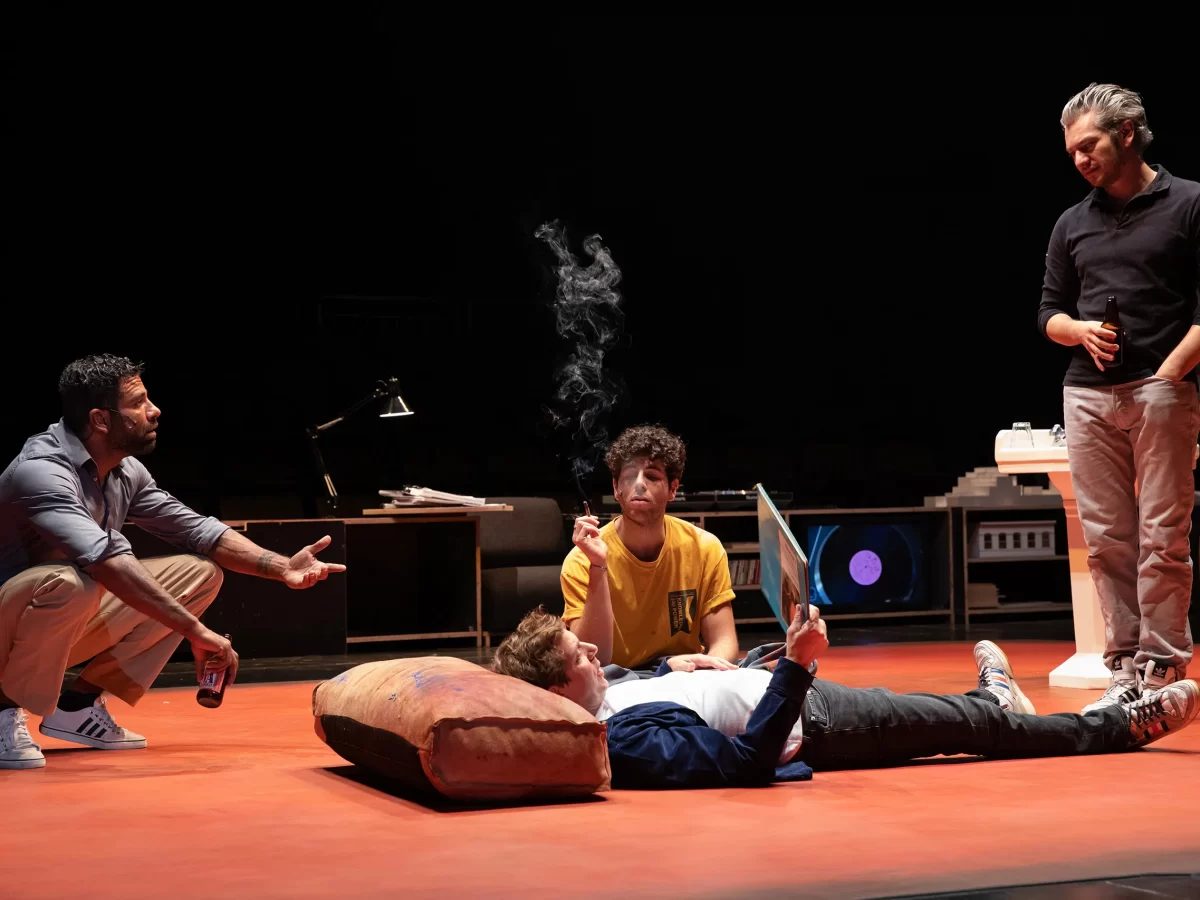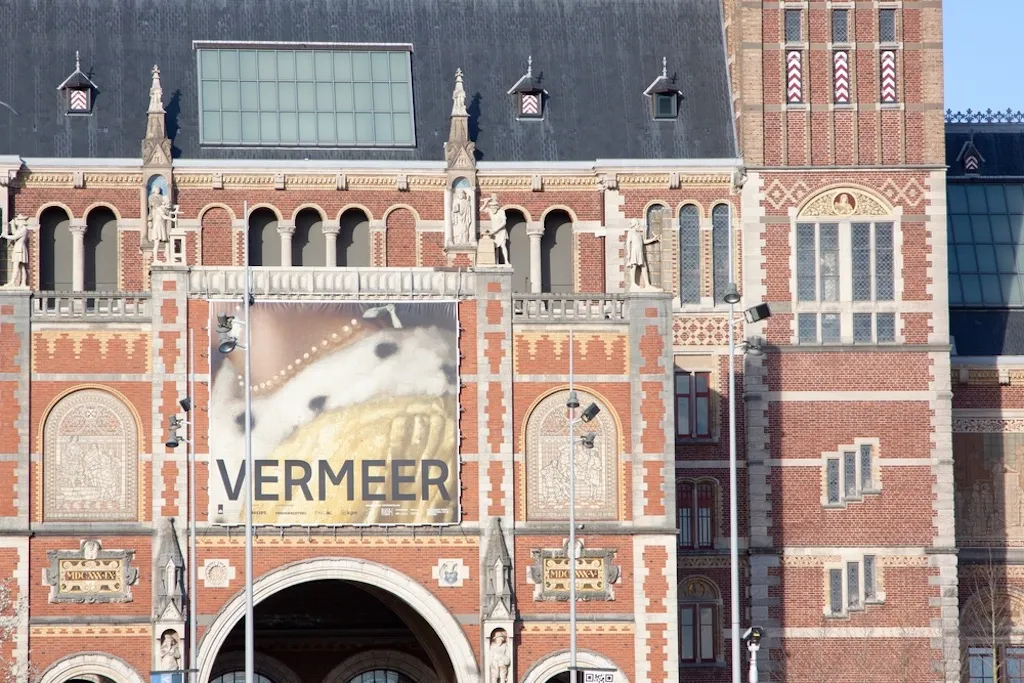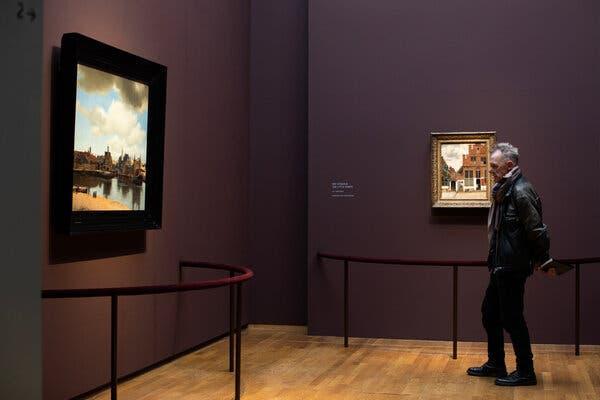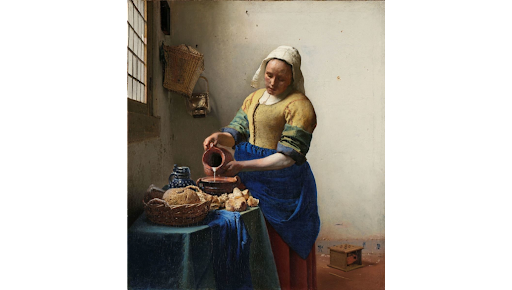By Cosmo Adair and Emma Large
For a more thorough explanation of Immersive Theatre, please refer to Max Shanagher’s article “Teasing the fourth wall”: A short Immersive Theatre manifesto,” pub. 6 November 2023.
Alexandria
Cosmo Adair
“Well, Fuck,” I thought to myself as the bouncer — the Roman one — confiscated my notebook and said, “That’s contraband.” This being immersive theatre, and me being supinely hungover, I didn’t want to interrupt his flow. I tried to discern whether this was a part of the play: in my head, I cursed the name of Max Shanagher (the co-director alongside Harry Threapleton) and pondered why he should invite us to review the play, only to pull off some cocky stunt and have one of his actors mug me and thus stymie my pen.
By the time I’d reached the bar (their very own bar, with Rome/Alexandria-themed cocktails: Red Roman, Nile Iced Tea, and Death by Passion), I started to think, “You know what, I really need that notebook. In fact, there’s no way I could possibly write a review without that notebook.” And so, I ordered myself one “Death by Passion”, drank it quite quickly, and then returned to the bouncer and spoke with the proud authority of a tipsy critic:
“Excuse me. I really hate to trouble you. But, you see, that notebook, I kind of need it actually. Of course, if — um —- only if that’s alright with you. But yes, I’m supposed to be reviewing this play.”
“What play?”
“Oh yes, sorry. Aha — I see now. It’s a Roman play, I believe.”
“Well, I’ll trust you this time.” Throughout our interaction, his face of cold, Roman hardness had not wavered. Lips sealed assertively, black moustache and dark sunglasses: he was Rome, or, rather, Rome-meets-humourless-celebrity-bodyguard. He was not going to break character. Generously, he handed over my notebook. And I immediately wrote this down: I thought it quite emblematic of the uniqueness of the experience offered by immersive theatre, and the challenges it poses both to its actors and to rather shy, awkward audience members such as myself.
Antony and Cleopatra is the second piece of immersive theatre which Tully Hyams and Shanagher’s Walkabout Productions have put on, following the success of last year’s A Wilde Night. On entry, each theatre-goer is presented with a choice: Rome or Alexandria. In effect, this is a choice between politics and romance. I chose romance: I got love and Cleopatra, whilst Emma had to suffer the steely machiavels of Rome. Only four others chose Alexandria, whilst about fifty travelled to Rome: either, they are more serious, or else they haven’t read the play, I thought. Given that most of the last two acts happen in Alexandria, I assumed those in Rome wouldn’t catch the play’s ending. But they did: at the Battle of Actium, the divider between the rooms opened and I caught a glimpse of Rome through the red mist of Actium.
Not only does the audience have to choose between Rome and Alexandria, but so too does Antony. That, to me, is the most successful element of the play’s staging: Ed Clark’s Antony flits between the rooms, endlessly, until he opts for a drunken Epicure Alexandria. But the characterisation of Antony, here, allowed for no doubt over his eventual choice: he was soft and effete, with a pony-tail, jewellery, and Doc Martens. He was always going to opt for Alexandria. This was effective when he was in Alexandria, but it did mean the central conflict of the play was slightly lost. Then again, I wasn’t in Rome; perhaps there, he was different.
Cleopatras have always infuriated me. Shakespeare’s characterisation of her temperamental nature lends itself to shrill, shallow, and over-acted performances. But not here. Alexa Thanni was excellent: the swift mood-changes were carried off with a subtlety I doubted was possible — not least in a student production. In Act 2, Scene 5, where Cleopatra beats the messenger, I usually switch off out of sheer irritation. Here though, Thanni delivered a scene which was not only comic but possessed a psychological realism. Another such moment to note was just after the interval when Antony and Cleopatra kissed. It was so genuine as to make the viewer speculate as to whether Clark and Thanni might be following the lead of their forebears Burton and Taylor.
Cleopatra was complemented by her supporting cast. Charmian, played by Clara Dammann, was especially good. The Alexandrian court is difficult to pull off – especially given how most of the talking is done by Cleopatra, and so the courtiers have to show their presence and attention without much chance to speak. Dammann’s raised eyebrows, rolled eyes, and covered smiles all accompanied well the depictions of Cleopatra’s whims and hysterics.
It was an interesting, thoroughly thought-out production, which made me consider these familiar characters and themes in a different light. I suspect it might be the first ever production of the play to take such an approach. The very feat of making the play work in an immersive fashion was impressive enough, but to do so with a student-sized budget and a student cast is yet more impressive. So, congratulations to all involved: not least to Shanagher, Threapleton and Hyams. And now, as Caesar says, “to Rome…”
Rome
Emma Large
The consequences of consuming several Death by Passions at 3:00pm on a Sunday afternoon hit me, rather unfortunately, during the launch of the Battle of Actium.
“Get away from the wall!” Caesar turned to us with a startling passion. “Get away from the wall!”
I, like the rest of the bumbling, bemused (potentially drunken?) audience, blundered uselessly to the left and stopped to await some further instruction from our ruler, as if the first hadn’t been clear enough. None of us had moved even remotely away from the wall.
“GET AWAY FROM THE WALL!” he roared.
Christ, I thought, we need to move. We scattered to the other side of the room to watch the partition, once deceptively solid, be rapidly drawn back, marking the dissolution of the geographical boundary between Egypt and Rome. The fourth wall and its tangible counterpart broke alike with dazzling intensity: the golden lights and secrets of Alexandria were revealed at last, like the glittering opening of a treasure chest. Those of us who had been cloistered in the purpled privacy of the Roman council room, envisioning Cleopatra from across the continents (summoned by Enobarbus’ famous lines, “The barge she sat in, like a burnish’d throne…”, still resonant in our ears), scanned the room for the Egyptians that we had heard rowing mutedly, from the other side of the wall. The play was not even at its interval, nor its dramatic climax; I had another Death by Passion yet to consume, but it was at this moment, the stage membrane shifting and permeable, that I understood the absorptive power of an immersive performance.
The stagnancy of the audience is fairly absolute in traditional theatre; we know our role is to sit quietly and to observe, to laugh and cry accordingly. In immersive theatre, I realised while stumbling to the other side of the stage during Max Shanagher and Harry Threapleton’s Antony and Cleopatra, the audience has no clue what their role is and what part they will be expected to play – and this is precisely its thrill.
In Rome, we were drawn from the margins to eavesdrop on the political quarrels of a fraught Roman council – until formally welcomed, by handshake, to the ‘Roman side’ – becoming equally complicit in their plot to win Antony back from Egypt’s seductions. Caesar (Olivia Clouting) simmered palpably with cool pride, his sudden flashes of fury both startling and exhilarating the audience, who were drawn into unnervingly close quarters in the small assembly room. The sultry, brooding movements of Octavia (Daisy Summerfield) provided relieving feminine contrast on a stage clustered with hearty Roman generals – to the credit of the all-female Roman cast (Antony omitted.)
Watching the performers flit around the central meeting table while they gesticulated and debated, I recognised that adapting Antony and Cleopatra into an immersive production had perhaps rendered it more open to interpretation than a traditional, more static performance. Each audience member, dispersed around the room’s edge, beheld every scene uniquely. As the actors circulated like the hands of a clock around a vital heart, the ever-darkening face of Caesar shifted in and out of view. The easing countenance of friendly Enobarbus (Francesca Singh) moved into my eyeline, before his back was then turned; I watched the left side of Mark Antony’s face (Ed Clark) as he protested indignantly to Caesar’s accusations, then tracked his right-hand side as he fled across the room. The dynamism afforded by immersive theatre electrified both the performance unfolding in front of us, but also our collective imagination. We wondered about the faces of the characters flashing out of our sight lines; about the events occurring in the neighbouring Alexandria; until the wall broke and all sprawled out before us as a figurative battleground between two nations, the room now bearing the strangely unifying quality of a no-man’s-land.
The play culminated in a thrilling final few scenes – the suicide of Cleopatra and her courtiers, I thought particularly moving. But as I left, I felt oddly guilty. Why? In his dying breath, Antony had reached out to me with his hand, a desperate supplication for help. I had stared back at him rather stupidly and recrossed my legs. You bitch, I thought to myself. Such a hopeless sentiment, I suppose, implies both the emotive power and incapacitating effect of immersive theatre – if I could have, I would have, Antony.

